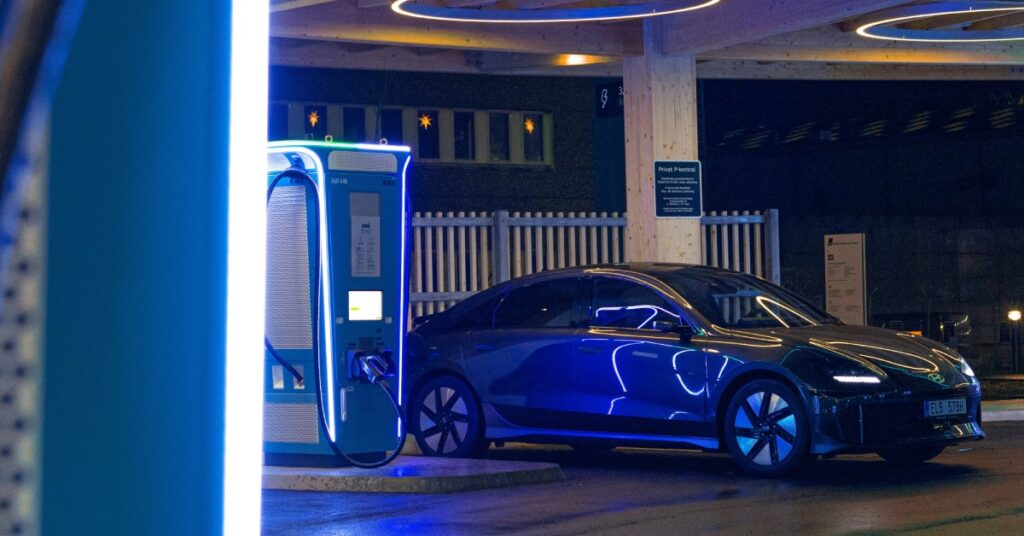Electric Vehicles (EVs) are quickly transitioning from the factory floor to our roads, with their popularity surging as environmental concerns grow globally. Charging stations are becoming increasingly common in parking lots worldwide. Unlike traditional vehicles, where refuelling at a gas station is straightforward, charging an EV involves a different process altogether.
How EV charging works
Charging an electric vehicle differs from regular fueling at a gas station due to its complexity. Unlike gasoline, which flows into your tank at a steady rate, the speed of EV charging can vary. Think of an EV battery as a large parking garage for electrons – the first 20% can easily find an empty spot, but the last 20% have a much harder time finding space. This makes the final part of charging slower than the beginning. An EV can reach 80% charge in about 30 minutes, while fully fuelling a regular car takes just a few minutes.
Another difference with EV charging is that the price fluctuates throughout the day, influenced by factors like weather, supply, and current demand. In Sweden, the average cost of charging an EV is 0.5 SEK per kilometer, compared to 1.3 SEK per kilometer for other fuels
Types Of EV Charging
There are different types of EV charging, each designed to meet the specific needs and priorities of the user.

AC Charging
Description: Alternating Current (AC) is the most common EV charging type. It can typically be found at workplaces and homes, due to it being cheaper than other options. The charging speed is however lower, meaning that longer charging sessions are needed to fully charge the battery.
Best use: Charging at home or workplace, where the EV can be connected for hours at a time.
Weakness: It’s slower than DC Fast Charging, making it less ideal for gas stations that aim for a quick customer turnover.
Charging speed: Depends on the charger and available power, but generally 3-22 kW.
DC Fast Charging
Description: The fastest charging method, optimized for speed. Utilizes the properties of direct current (DC) to give a high power charge.
Best use: Quick charging sessions to get on the road again, especially trucks and taxis that drive long hours and need to drive to make money. The cost becomes less relevant in these situations.
Weakness: Higher cost per session, compared to AC charging.
Charging speed: Generally around 50-150 kW, some super chargers can reach 350 kW.
Smart Charging
Description: A data analysis approach to optimize the charging by finding the optimum and cheapest time to charge the car. The method takes full advantage of lower electricity prices, utilizing the variation of demand and supply. Smart charging thus saves money and helps the grid by charging during off-peak hours, spreading demand more evenly.
Best use: Longer charging sessions at home or work. The longer the session, the more optimal the charging.
Weakness: Must leave one’s vehicle for a longer period of time, meaning that it’s not effective for fast charging.
Problems and solutions
EV Charging Costs
Cost efficiency: Battery and EV charging technology will continue to advance over time, driven by the growing demand for cheaper charging options, which in turn spurs further investment. Innovations in AI and software will enhance efficiency and help lower costs even further.
Peak Energy: Our software leverages data and advanced features to optimize every charging session, reducing costs. It combines smart charging with other techniques to achieve maximum efficiency. The software also enables the use of frequency regulation to stabilize the grid while generating revenue, and it allows seamless integration of solar power with an automatic priority system for EV charging.
Adapting to the Future of EV Charging
Faster charging: Improvements in battery and charging technology will gradually decrease the charging time.
Battery Swapping: Swapping out an EV’s empty battery for a fully charged one, much like changing batteries in a device, could be done through a machine designed to safely handle the heavy weight. This process would likely be limited to specific locations, such as gas stations. While the technology isn’t available yet, it holds potential for the future.
Change in habits: We live in a society accustomed to the conveniences of our current technologies, like refueling a car in just minutes. However, change is inevitable, and it requires us to rethink our driving habits and trip planning. Expectations will need to shift, with less reliance on spontaneous refuelling stops.
Lacking Charging Infrastructure Leading To Range Anxiety
More Charging Stations: As interest in EVs grows and more hit the road, the number of charging stations will inevitably increase. The market responds to demand, and government subsidies could further accelerate this expansion.
More Charging Spots: EV charging can be accessed at a wider range of locations, including at home, work, or in parking garages. Refuelling a car is no longer confined to a visit to the gas station, offering greater flexibility and a broader time window for charging.
Peak Energy’s solution
Peak Energy takes EV charging a step further to achieve a more efficient charging that is more customizable for the end customer. By utilizing more relevant data and attributes Peak Energy can provide charging patterns that are more aligned with the interest of the user.
